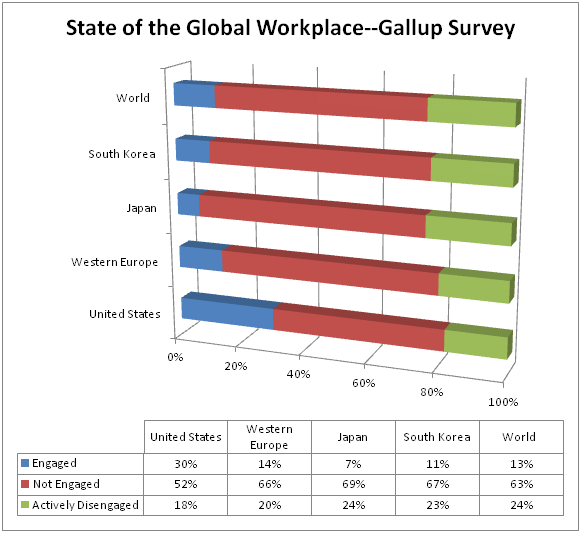The Peninsula
Employee Motivation is Critical to Creating an Innovative Economy and Jobs
Published December 4, 2013
Category: South Korea, Current Events

By Phil Eskeland
Last October, the prestigious Gallup organization released a study1 that reported on the level of employee engagement in the workplace based on surveys performed during 2011 and 2012 in more than 140 countries. The aim of this study was to encourage companies and policymakers to support initiatives to increase the number of productive and motivated workers in order for their employers to successfully compete for the estimated $140 trillion in new business opportunities that is expected all across the globe over the next 30 years.
What does it mean to have an “engaged” workforce? In short, these employees are motivated to come to work. They have a meaningful and rewarding job by taking satisfaction in a project well-done. In contrast, employees who are “not engaged” in their workplace believe they simply have a job – not a career. They come to work just to punch the clock to receive a paycheck that will provide other ways for them to obtain personal satisfaction. However, the more toxic combination are employees who are “actively disengaged” from their job. These individuals are unhappy in their employment and their attitude may sabotage the long-term health of the enterprise.
According to Gallup, “organizations that maximize employees’ motivation and enthusiasm for their work are in turn helping to stimulate job creation. Globally, 44% of engaged employees say their employers are hiring people and expanding the size of their workforces vs. 34% of those who are not engaged and 25% of actively disengaged employees who say the same.”2 Thus, to increase jobs and secure a greater share of future business opportunities, nations should work towards increasing their share of the “engaged” workforce.
High scores for young Koreans on reading, math, and science tests are just one part of the puzzle to developing a growing and innovative economy. However, the Gallup survey reveals that Korea falls into a similar pattern with other East Asian nations that have the lowest proportion of engaged employees in the world. While Korean workers are not as discontented in their job as their counterparts in some other nations, the relatively high percentage of employees “not engaged” in their job should send a warning signal that more needs to be done by Korean companies to motivate workers to look forward to coming to work each day. In fact, the Gallup survey also revealed that only 55 percent of South Korean workers said their job is ideal for them – the lowest response rate in all of East and Southeast Asia, including China and Japan.3
One of the reasons why the United States has succeeded over the years is because of its entrepreneurial spirit and willingness to reward initiative. Sometimes, this means bypassing seniority in order to get the right person into the job. Sometimes, this means listening to the good idea that is raised by a junior employee in the back of the room. The United States has a culture of rewarding the best talent. This is reflected in the Gallup survey that reveals 30 percent of the American labor force is engaged and motivated to perform well at work, which represents the highest rate among all developed nations.
Over the past several months, Korea has launched a number of initiatives to create the innovative economy of the future in order to foster job growth. These programs are all well and good, but another important component to developing a creative economy will be how Korean companies develop a sense of engagement in the workplace. If they are able to exceed, or at a minimum match the world-wide average of an engaged workforce, government efforts to foster a creative economy will have a greater chance to succeed. Imagine what an economic powerhouse Korea could become if it doubled the percentage of its engaged workforce! According to Gallup, there is already a group of Korean organizations that have implemented strategies for motivating the workforce that has produced more than 60 percent of their employees engaged in their jobs. “These findings demonstrate that cultural influences alone do not determine the way Korean businesses are organized or managed. Those that emphasize employee engagement through awareness efforts and targeted interventions are able to raise engagement levels far above the country average.”4
There is a saying in America that “people are your greatest asset.” This should be the motto of every business in the world.
Phil Eskeland is the Executive Director of Operations and Policy for the Korea Economic Institute of America. The views expressed here are his own.
Photo from Dell’s Official Flickr Page photostream on flickr Creative Commons.
1 State of the Global Workplace (http://www.gallup.com/strategicconsulting/164735/state-global-workplace.aspx) October 2013.
2 Ibid., page 7
3 Ibid., page 36
4 Taek Lee, Danny Lee, and Cheong Im, “South Korea’s Missed Economic Opportunity,” State of the Global Workplace ( http://www.gallup.com/strategicconsulting/164735/state-global-workplace.aspx), page 67.
